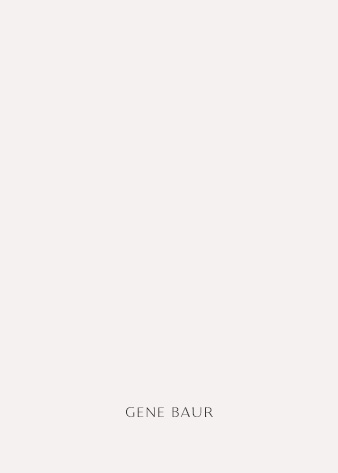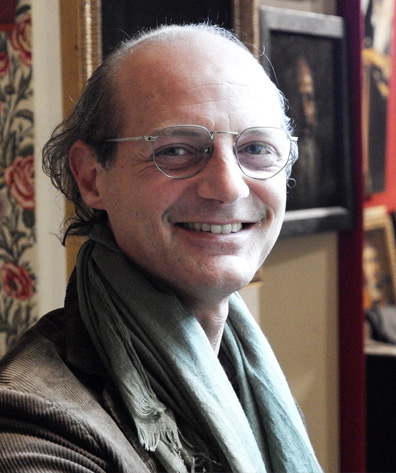
“Once you have focused
on who you are and what you want,
you must concentrate on the goodness
of your choice and go for it.”
MASSIMO TIZZANO
Classical figurative painter, IT
March 8th, 2023
OPEN WINDOWS | In Conversation
Heera Alaya: The fabric panelling in your atelier [on Via Margutta, Rome, Italy] caught my eye.
Massimo Tizzano: My atelier was a tissue shop; the layout and furnishing were in place when I took over. I considered changing the furnishing but left it in its original state because the tissue tapestry gives a pleasant sound.
The fabric-covered walls soften your atelier’s ambience. It’s intriguing how this space happened organically for you.
My life is full of strange coincidences. Many years ago, I was lucky to meet my Norwegian painting master [Odd Nerdrum] 30 minutes from my atelier at a bistro full of white sculptures—
I know which cafe you are talking about—it’s double-level with red walls.
Exactly.
Talk about coincidences!
I had an appointment to meet my painting master at Santa Maria di Popolo [beside Piazza del Popolo], but my train was running late. I took a taxi to the bistro (the one we were talking about), and as we approached the meeting place, on spotting my painting master [Odd Nerdrum], I instructed the taxi driver: “Stop here, please.” You have to understand this moment—two years after my studio assistant application, I finally met my painting master.
Exactly ten years later, a dear friend gave me the opportunity to rent my first Roman atelier [Massimo’s atelier in Via Margutta, Rome] just thirty meters away from the bistro where I met my painting master.
Incredible.
It was an eventful period in my life. The day before my friend informed me about the opportunity to rent this property [Massimo’s Roman atelier], my wife and I were feeling low due to COVID-related adverse times. We [Massimo and his wife] were considering setting up a small gallery near our house in Calabria [Southern Italy], in a beautiful touristic place called Diamante. Things seemed to work out, but we couldn’t finalise a favourable arrangement with the gallery property.
The evening before meeting my friend [who recommended the property in Rome], I told my wife not to be so sad: “We will have a new opportunity tomorrow.” And the moment we so badly wanted arrived exactly the day after.
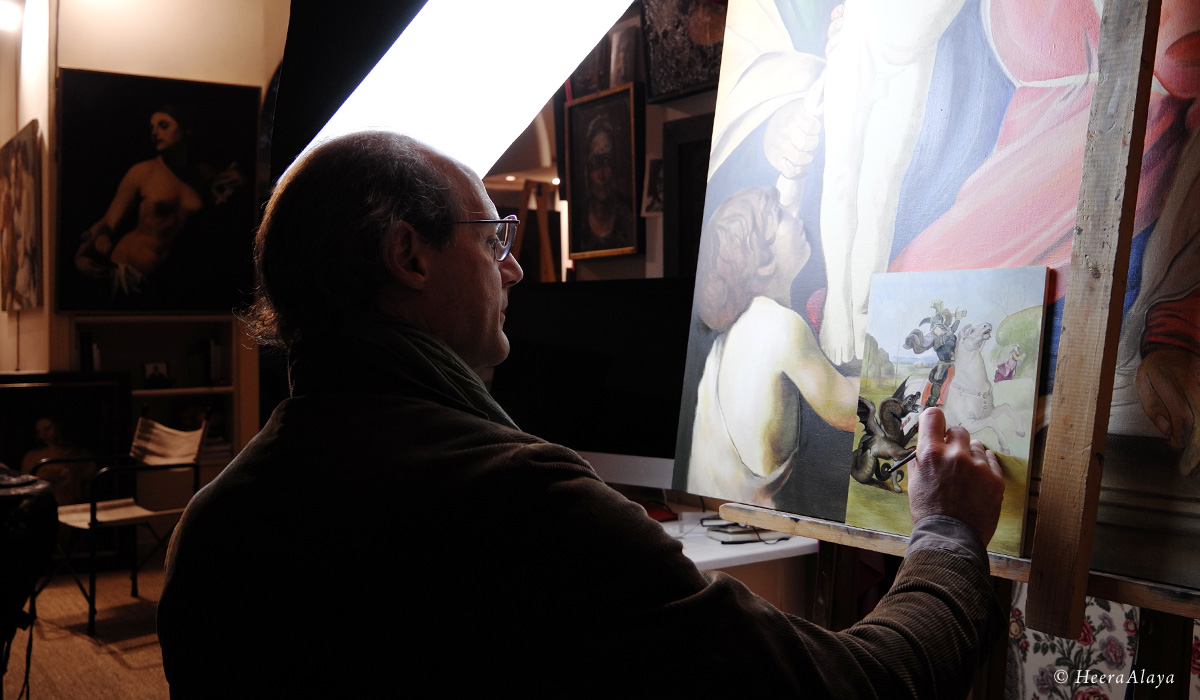
You have studied Indian music and Japanese Calligraphy. How have these varied subjects come to aid your development as an artist?
As a child, I was sensitive to music and art and always drew or played musical instruments. But my family didn’t want me to follow my passions, so my studies were completely different from my interests.
I made a long journey before arriving at painting. During this period, I studied Japanese martial arts and Indian classical music (I had some talented masters from India.) and studied tabla and sitar with the help of the Fondazione Giorgio Cini in Venezia—a foundation merging Eastern and Western cultures.
Then, I met Norio Nagayama, my Japanese calligraphy master. I followed him for about ten years and trained diligently. In Japan, like in India, there is a deep respect for your masters, and learning art is about copying the Old Masters. So when I decided to move from my hometown, Padua [Northern Italy], to Calabria, I had some free time and oil colours, and I thought: “Let’s see what happens.” Similar to my Japanese calligraphy approach, I started copying the Old Masters. And after this, I tried to sell my works, which somehow worked [Laughs].
Would it be correct to credit Japanese calligraphy as part of your foundational journey to reach your passion—painting?
Yes. All my experiences and learning are tied to painting. I journeyed to the East and returned to the West with lessons I learned from the East. The difference between the West and the East is probably that in the West, we have forgotten the meaning and importance of our history—our artistic and cultural past.
Indian classical music constantly references the past—a singing style called Dhrupad, which means unchangeable. The same sentiment exists in Japan—traditional arts are still alive after centuries. They [arts] were transmitted from mouth to ear for many years directly from the master to the pupil. You cannot find this tradition in the Western world anymore.
You appreciate your journey to the East.
For sure [values his journey]. Travelling was necessary for my development as a human being. What I couldn’t find in the West, I found in the East, and everyone in the Western world must journey to the East—to look for a master who can teach you profoundly.
You talk about personal development, which is essential. You can reside in the most beautiful region but only develop facets if you leave your comfort zone and experience different terrains for extended periods (travelling in the truest sense).
For sure.
You have travelled extensively, including to Norway and Japan. What has the journey done for you individually?
The interesting aspect about this path is that, in some way, the world outside of us and inside us combine. By learning a traditional art, you can reach a point where these two realities become one, so you become one. You find that your heart is the heart of other people and nature, and your breath is the breath of the universe.
For how many years have you been painting?
About fourteen years.
What was the final push to get you painting?
When I painted, I experienced a meditative state of mind. I could paint for hours without getting tired. It is essential to do a job that doesn’t tire you and doesn’t negatively affect you, so I decided to paint.
Do you ever start a painting and abort it because it’s not going how you want it to?
Yes, many paintings. [Pointing to a painting] That one, for example, I aborted three or four versions. [Laughs]. If someday, someone makes an X-ray of my paintings, like of the Old Masters, they will find significant changes, not just about the position of a finger.
How did you convince your painting master, Odd Nerdrum, to accept you to train under him?
I was already painting when I saw his [Odd Nerdrum] paintings for the first time and thought he was a master from the 17th century. When I learned this painter [Odd Nerdrum] was alive and open to receiving applications, I tried contacting him. I connected with his wife [Turid] on Facebook, who asked me to send photographs of my work and a presentation letter. My painting master approved but also asked me to submit a self-portrait, which I did. They [Odd Nerdrum and Turid] responded: “We are coming to Rome. Can you meet us?” We met in Rome.
Risk-taking is essential. We have so many self-doubts—should I, what if, could I?
We must try to follow the path even if it takes work; take some risks. In the Christian world, Jesus says there is a large and narrow way.
Of approaching life?
Yes. You have an easy way to do things and a more complex way to do something. We usually try to go through the easy way because we don’t want to have problems, and in the bargain, we sacrifice part of ourselves.
If you want to be coherent with your ideas, goals and who you are, you must make a little effort and follow the difficult path.

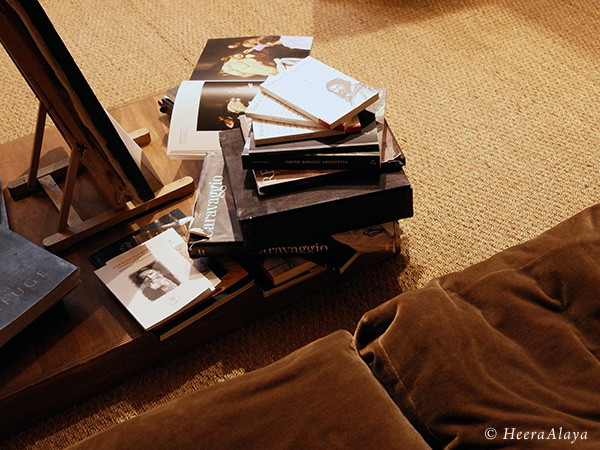
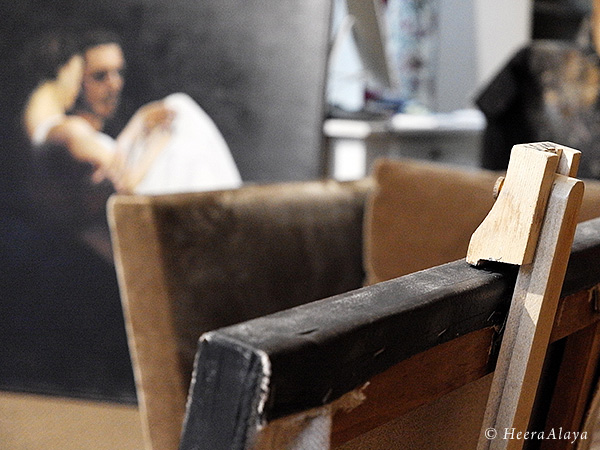
What inspires you about Caravaggio’s [Italian Baroque painter] work?
We are talking about a period of great development of the arts, thanks to the interest and commissions from the ecclesiastical world, noble courts, and rich merchants. A long season in which, at a certain point, Caravaggio appears on the scene, a man with great energy, a strong character and great knowledge of the best Greek art. His [Caravaggio’s] pictorial flair and vision of his existence made him the father of a new and never-before painting style: we are talking about realism.
His fruit basket, with the rotten apple, the withered grapes, and the crumpled fig leaf, is the beginning of a new way of viewing the world in painting. With Caravaggio, it is as if suddenly, in painting, we passed from the platonic ideal to Aristotle.
Caravaggio’s work is much better than most contemporary artwork and post-modern things, inspiring many people, including me. But I am a critic of the prominent painter [Caravaggio].
What do you mean when you say you are Caravaggio’s critic?
More than towards him [Caravaggio], I remain critical of the historical epigones deriving from his revolution. He [Caravaggio] was a genius, no doubt about it.
Caravaggio had excellent skills and was also a great scholar, an unknown aspect of his personality. But his [Caravaggio] paintings changed and became something more about theatre than an instrument to start contemplating. For example, in the medieval world, when they made icons—they are still done today—it was instructive as a work of art; an icon tells a religious story. But the main reason icons were made is that they had a sacred geometry inside, like a mandala [geometric configuration], like a yantra that you use for contemplation to enter another state of mind, which brings you more depth of yourself.
With Caravaggio, everything is spectacular, like special effects—you have the light and the compositional dynamism, and it is close to theatre, a dimension I like. Caravaggio still has something important to give to humanity, especially these days. Nowadays, people look at paintings and say: “This is good for my space; it has nice colours like my sofa.” People don’t look for emotions or a story; they look at the aesthetics—if it [painting] fits with the dining room, it’s good. But what do they want when they go to the cinema? People look for something that gives them emotion. In Caravaggio’s painting, you have this emotion.
Can you talk about the Dutch artists you study?
Let’s talk about Rembrandt, for example. There are two aspects I look for in a painting (this is also why I am eclectic.). There is a spiritual aspect, and there is a human aspect. So you have the finite (the representation of the human limits) and the infinite (the representation of the unknown).
With Rembrandt, you have humanity, especially if you look at his last self-portraits. Rembrandt has short brush strokes and intense expressions—of sadness about the poor state in which he lived the last period of his life. Rembrandt’s paintings have spiritual teachings—you can see an older man with colours on his palette who can represent drama with just a few brush strokes. And in the sad spiritual state—we don’t want to be sad—we are comforted, similar to when listening to sad music.
Sadness reminds me of Van Gogh [Dutch post-impressionist painter]—a sensitive soul whose art has this intensity that encourages me to be in the moment, feeling his presence. Van Gogh’s journey, letters and paintings evoke great sadness, bringing me to tears.
I cried in front of a Van Gogh [painting] the first time. I hear about this reaction [being deeply moved] often.
Are there any other artists from whom you seek inspiration?
There are so many artists. I am also interested in specific Flemish painters. My interest is historical; I am interested in their [Flemish painters] technique and the special effects they could attain in their paintings. And also the expression of a clear view of things. For example, many Flemish painters are skilled at recreating material—wood, metal or brocade, on a painting. It is fascinating to represent all these materials in such a realistic way. To represent reality in such a way, you have to become the reality.
Going back to what we said before—it is an identification process. Leonardo [Leonardo da Vinci, an Italian polymath] also wrote about one of his paintings: “If you want to paint something, you have to become what you are representing.”
Also, when contemplating a painting, if you can put yourself aside, you can enjoy it; try to make an empty space inside you with a clear mind, and let the painting speak to you. Your ear—not your eyes—becomes open to hearing what the painting tells you.
Different periods use different tones, and you have to stay with the period. How do you organise your work, and how do you mix colours?
I have to stay with the period, materials and mediums. For instance, in the past, they used only walnut and linseed oil, mixing them with some resins and other ingredients. The mixing technique is different for each master. I use a limited palette for my paintings, which arrived through a Roman Scholar, Palma il Vecchio, who explains to us the palette of the most famous painters of the past–Apelles [ancient Greek painter], the painter of Alexander the great. These four sacred colours—white, yellow, red and black—are used in many traditions. Mixing these colours gives you many combinations and the chance to build a painting with a great harmony of tones and shadows.
I am currently working on Raphael [Italian painter] and Caravaggio, who use the same palette in many paintings. However, to replicate Raphael, you must use many different shades of colour.
You have plenty of colours (including shades of gold). Do you have different palettes for different artists?
No, I am not so organised. I take some time to study every painting to see which pigments I need; then, I start mixing the colours, which are different for every painting. You have some fundamental pigments with specific preferences. I don’t have a box for Raphael, a box for Vermeer [Johannes Vermeer, Dutch painter] and a box for Caravaggio.
[Laughter]
How do you get the exact colour tones, for example, of Terre Verte or Burnt Sienna used by Old Masters?
I try my best [to get accurate tones]. The result of my work will be different from the original. Every time I approach an Old Master Study, I try to go to a museum to see the original old painting with the patterns; it is like looking at the painting through a filter, given the age and the yellowing of the patina from the varnish.
To avoid misunderstanding, you can use the results of the scientific examination of the paintings—take a small part of the painting, analyse it under the microscope, and see how many layers there are from the ground to the varnish.
Pigments on old paintings are from a different era. How do you source authentic pigments?
Some big shops sell all kinds of pigments and materials and antiques. You can also source material through the Internet.
You travel back in time and live through different eras of painters. Have those periods become you?
I am mirroring myself with these eras. Most people are mirroring someone who reflects them. When we are interested in something, we already have that inside of us. We need to see its reflection to see it better.
Is there a specific colour pigment that speaks to you?
It’s interesting you say, “a colour speaks to you”—colour is static. My name as a Japanese calligrapher–Oto Mi–is to see the sound. Oto is sound, and Mi is to see. It is a wish to see the sound; it is like hearing a painting, which is standard in Indian culture. For example, in Indian culture, the musical nodes are denominated Ragas, which means “colour”.
I like almost every colour and appreciate the way colours are organised. If there is harmony, it is good. So painting is a question of organisation. The right proportion is crucial—the correct ratio of dark and light, the right balance through force and lines, and the accurate proportions of colours to mix well, resulting in a quality painting.
The pigment I like the least is blue—it is a sort of poison in painting, so we should use it to a minimum.
How do you stay organised with your brushes and palettes?
I organise daily—I clean my palette and wash the brushes at the end of my day. My painting Master removes some colour with a rag and dips the brushes in linseed oil to maintain their softness. But with this technique, the oil penetrates the brush with time. So, I clean my brushes with oil and then wash them with neutral soap.



As a sensitive-creative individual, how do you deal with life’s challenges while simultaneously focusing on creating art?
Creating art while dealing with life issues is tough. Despite societal pressure, world news, and other complicated occurrences, we must have a clear target and be brave enough to take risks for maximum results. We must also know in what name we sacrifice everything.
Pardon my interruption. You were painting through the worrisome COVID period—
Sure.
How did you compartmentalise—put your problems aside and focus on the rituals and techniques to remain on track?
It was challenging. But I try to be centred. My training in martial arts, Indian classical music, and Japanese calligraphy gave me instruments to face this period [Covid]. In this sense, I have been lucky. And I didn’t waste my time before; I try not to waste any minute now.
So we should be in this vision for our life—try not to waste a second because everything changes so fast.
I had two friends who died recently, like that [gestures in a snap].
We take tomorrow for granted.
Yes. Procrastination is a primary teaching. We should be aware of our present moment, what we want to do, and our targets. Being focused doesn’t have to make us anxious to reach our goals; rather, it aids in working in the now.
And enjoy the process.
It is very important to enjoy the process. You don’t have to think, “I will be happy when I get the result,” you have to be satisfied now.
What is your working process for commissioned projects?
I am not interested in taking on an assignment and the money and handing over the painting. I keep the [painting] commissioner involved from the start to the end, whether it is a portrait or a Master study. By involving the commissioner, I hear their impressions, enabling me to accomplish the desired results.
It is a collaborative journey.
Yes.
Does your education in business and commerce enable you to sell your works of art? Or do you have a partner who takes care of your business?
I recently signed a partnership with a significant communication agency. It is challenging when you have to think about everything. Moreover, I am terrible with social things.
I wish you the very best.
Thank you. I am delighted and curious to see what this union will bring out.
As my interest in art developed, I started closely observing Old Master’s frames—ornate frames adorning Botticelli [Sandro Botticelli, Italian Renaissance painter] to restrained frames presenting Van Gogh [Vincent Willem van Gogh, Dutch Post-Impressionist painter]. How do you choose your frames?
Every painting has its characteristics, and we should not overrule them. I am intuitive and find frames that enhance a painting, bringing out its best.
The painting dictates.
Yes. [Pointing to a painting featuring Massimo’s nephew] I had an idea for that painting, a scene from Macbeth. I preferred a dark frame inscribed with a famous monologue from Macbeth, taking into consideration the darkness of the painting and the brightness of the lady’s dress.
How interesting! Did you commission the frame?
I did. I will show you the frame on my computer.
That will be lovely. Thank you.
If you put a gold frame around a painting like this one [Macbeth], you will ruin it—light around a dark painting kills the painting; you need to lift the painting. And this can be a rule—avoid light frames around dark paintings.
[Observing the frames in Massimo’s atelier] You don’t get to see such beautiful frames. Do you work solely with an Italian framer?
I know some authentic framers who are great artists. [Pointing to several frames]. Those are pure gold decorations.
Your wooden boxes caught my attention.
They [wooden boxes] came out of a need. I had to ship an attractive painting to Connecticut [USA], a Master Study—Saint Sebastian [1495 painting] from Pietro Perugino, an Italian master of the 15th century. I wanted the client to receive the painting and enjoy it rather than deal with layers of cardboard and plastic.
So, I started constructing a box with a velvet interior, which was the perfect final fit for my painting. Those were crazy times—I was painting and making boxes.
What does the butterfly on the boxes represent?
The butterfly is a symbol I derived from the school of my Norwegian painting Master [Odd Nerdrum].
Is placing a butterfly on the wooden boxes your way of honouring your painting master, Odd Nerdrum?
Yes. I also try to be grateful and think about my masters’ every day, who gave me so much. We should regain this respect in some way.
How many paintings do you work on at a given time?
Three to four [paintings]. I also use the non-direct method of the Old Masters. You paint through layers, letting a layer dry before painting new layers. This process allows you to work on several paintings at the same time.
Have you ever felt such a strong emotional attachment to a painting that you didn’t want to let go?
With every painting [feeling attached]. I worked on some paintings for more than nine months and years to realise, so the paintings became a part of me. But I am happy when I find them a good home, like when a son or daughter finds a good partner. But one should not become too attached to anything.
Buddhism has a concept of non-attachment—
You know many things about doing something. Are you a painter?
I appreciate your noticing. I wish I were a painter. Basic watercolour painting doesn’t qualify. Neither can I play a musical instrument to save my life!!
[Laughter]
I am a sensitive soul driven by curiosity and learning.
So you can understand.
Yes. I can stand for hours before a painting, appreciating the nuances—the light source, the brushwork and the fabric detailing. I am always enamoured by face structures and ornaments from different eras, trying to understand pigments, spatulas, etc., and admiring the frames. When I go into a museum or an atelier, it’s intentional—I want those moments to be an experience that becomes part of me.
This [intentional being] makes the difference.
I listened to a radio program about how people move inside a museum, where they were trying to calculate the time people spend in front of a work of art. The number of people who spent three minutes in front of a painting was so small it didn’t have importance in percentage. So, the study went into audience attention for one minute, which was also insignificant. The study had to go down to a few seconds to see the maximum attention span. To go to a museum and stay in front of the art for ten seconds doesn’t make sense.
I wouldn’t have guessed people zip through museums. But I suspect the day is not too far when a suspicious security guard picks me up and throws me out of a museum for spending way too much time!
[Laughter]
Your nephew modelled for your painting inspired by one of the most famous soliloquies in English playwright William Shakespeare’s tragedy Macbeth. Does your nephew have to be a live-sitting model, or do you take photographs?
I often need to take photographs, even if it’s against the teachings of my master, who works only from life. I witnessed his [Odd Nerdrum] commitment one cold Norwegian winter. My master was working on a portrait of his wife and needed a little piece of velvet to place on her shoulder, so he went out in this freezing, windy weather to get the lace.
When you have a real person in front of you, he is vibrating; he is resonating with the light, which allows you to add depth to your canvas, making it come alive.
Copying a Master’s work is different—you already have a human version, a three-dimensional creation on a canvas. But when you make a portrait from a photograph, it is a poor reference as it does not come from a man’s hand and heart. Unfortunately, I work from photos because only some people are in the position to model for you as it is time-consuming and requires multiple sittings. If you need to copy from a photo, your goal must be to give life to that frozen image. It also helps to make a short video of the model to have movement.
What are your most significant challenges while painting?
The greatest challenge is creating a painting with an aliveness that becomes a source of good energy. When you are with your back to the painting, that painting is still operating.
Speaking of good energy, I felt it as I strolled on Via Marguatta one early morning and crossed your atelier; its positive energy is magnetic.
Energy is not apparent to people, but everything is energy. We surround ourselves with many things, and surrounding ourselves with objects made with good intentions can make a difference.
What significance does it hold to have your atelier on Via Margutta?
Do you know the story?
Via Margutta is a beautiful street that once housed the finest artist ateliers. I would love to learn more.
Exactly. Since the 17th century, Via Margutta has dedicated itself to the arts and hosted the finest painters. Father and Daughter Painters Orazio and Artemisia Gentileschi [Italian Baroque painter] had ateliers on this street. Artemisia was one of the greatest female Renaissance painters (a contemporary of Caravaggio). Many artists chose this street to start workshops because the rent was cheap until the late 20th century. In the 50s, there were about 800 artists—70 percent painters and 30 percent sculptors. Via Margutta was a very creative environment. Picasso [Pablo Ruiz Picasso, a Spanish painter and sculptor] had his first Studio in the building facing us.
Do you know that the famous Hollywood film Roman Holiday [starring Audrey Hepburn, 1953 Academy Award winner] was shot on this street [Via Margutta]?
I do.
And that building facing my atelier was built to host artist studios. You can see the description at the gate: “Studio per pittoti e scultori [Workshops for painters and sculptors]. Then the real estate market took an interest in Via Margutta, and they began to buy the properties to turn into luxurious apartments, bed and breakfasts and so on. So, the artists started to move from here because the rents were soaring.
Does Via Margutta’s energy contribute to your work?
For sure. Even if you are only aware of it sometimes, think about the many painters who passed along this street, the many works, and the many ideas. Via Margutta has an exceptional taste compared to other streets dedicated to shopping.
True. The noisy, packed shopping streets are a far cry from the quiet charm of Via Margutta, which has a different vibe.
Yes. Completely different vibe.
You told me how your life journey started differently to eventually reach this point. Not all of us are fortunate to have perfectly stretched canvases to build our lives. What would you say to youngsters who don’t have a perfectly stretched canvas? How can we undo parts of the canvas and re-stretch it to make it our own story?
It is tough [to re-stretch your canvas]. But once you have focused on who you are and what you want, you must concentrate on the goodness of your choice and go for it. You must not ruminate about what my parents, my brother, or my friend will think. You must defend your right to do what you want, letting the world know you are committed to owning your life and taking risks.
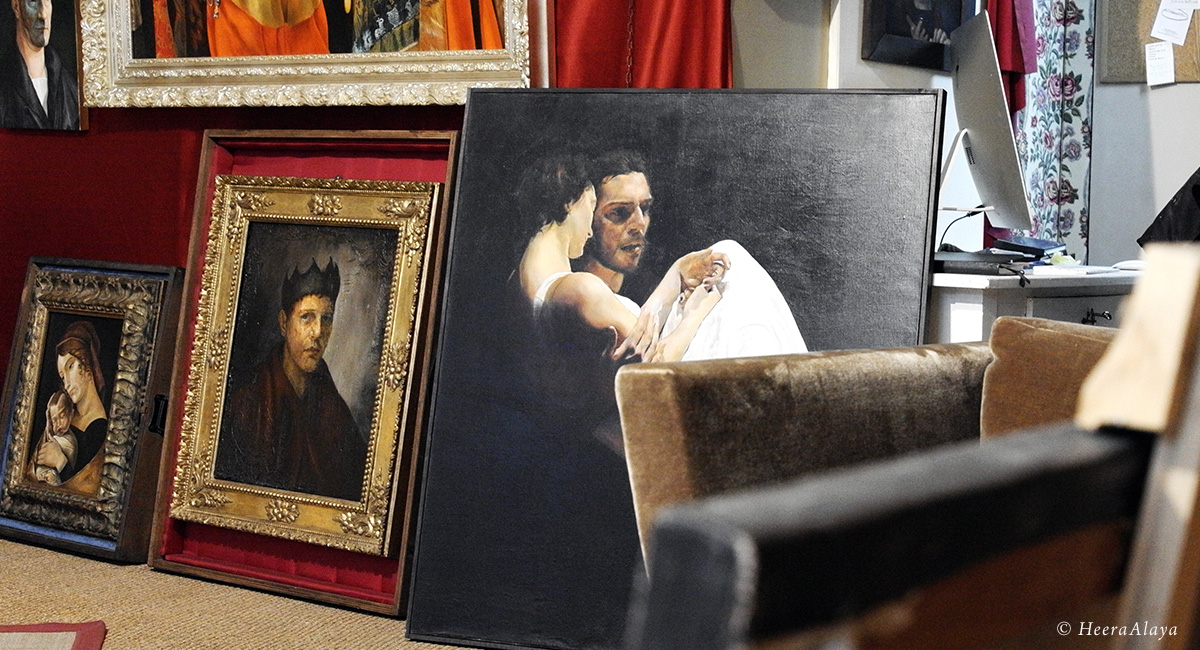

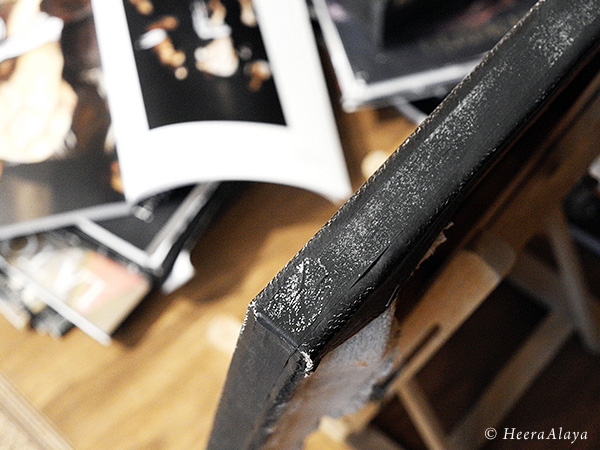
The day of our conversation had pleasant coincidences. Massimo didn’t know his nephew was arriving in Rome; his nephew didn’t know the sold Macbeth painting hadn’t left his uncle’s atelier, and I didn’t know Massimo’s nephew would be present or that I would get to see a photograph of the frame. Sharing this personal, poignant moment with the artist and his model nephew was special. Massimo showed me a picture (on his computer) of the frame he had commissioned for the Macbeth painting. The thought invested in selecting a complementing frame and details—soft gold lettering with a worn-out effect—makes the frame exquisite.
Massimo’s nephew [the model for the Macbeth painting ‘Tomorrow and tomorrow and tomorrow’] expressed his gratitude for his uncle: “Performing the Macbeth scene was an emotional moment. Not only did my uncle [Massimo] capture this moment on film, but he also painted it far better than the film.
Learn more about Massimo Tizzimo.

